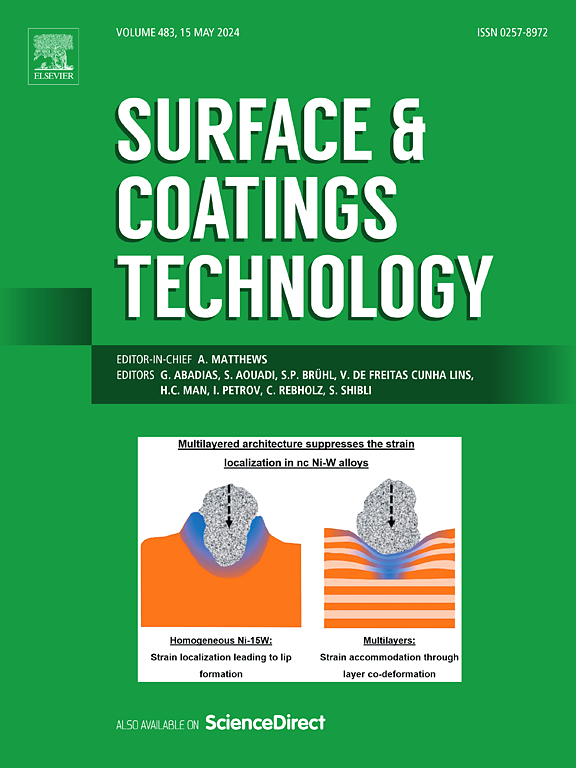Enhancing fretting corrosion resistance of micro-arc oxidation coating with Y2O3 nanoparticles on biomedical Ti6Al4V alloy for hip implants
IF 5.3
2区 材料科学
Q1 MATERIALS SCIENCE, COATINGS & FILMS
引用次数: 0
Abstract
In this study, MAO coatings were fabricated on biomedical Ti6Al4V alloy by incorporating varying concentrations of Y2O3 nanoparticles into MAO electrolyte. The growth characteristics, microstructure, and mechanical properties of the coatings were then analyzed in detail. Fretting corrosion experiments were subsequently conducted under conditions simulating the actual head-neck interface of artificial hip joints. The influence of Y2O3 nanoparticle additives on the coatings' fretting corrosion performance was comprehensively evaluated. The results showed that the incorporation of Y2O3 increased both the transient processing voltage and the Zeta potential of the electrolyte, thereby accelerating coating growth. Y2O3 (4 g/L, 8 g/L) markedly enhanced the density, uniformity, and thickness of the coating, resulting in improved microstructural characteristics. Additionally, Y2O3 (4 g/L, 8 g/L) significantly improved the mechanical properties of the coating, including hardness, elastic modulus, and adhesion strength. Moreover, Y2O3 (4 g/L, 8 g/L) substantially decreased the friction coefficient, frictional energy dissipation, fretting corrosion volume, and corrosion current, thereby significantly enhancing the coating's resistance to fretting corrosion. Compared with the substrate and coatings without Y2O3, the Y2O3-coatings (8 g/L) improved fretting corrosion resistance by factors of 10.7 and 4.7, respectively. Notably, after the addition of Y2O3 (8 g/L), the dominant fretting damage mechanism transitioned from fatigue and adhesive wear to scratching and minor deformation. The findings of this study lay a valuable foundation for the optimization of MAO coatings and the protection of the head-neck interface in artificial hip joints.
Y2O3纳米颗粒微弧氧化涂层增强医用Ti6Al4V合金髋关节植入物抗微动腐蚀性能
在本研究中,通过将不同浓度的Y2O3纳米颗粒掺入MAO电解质中,在医用Ti6Al4V合金上制备MAO涂层。详细分析了涂层的生长特性、微观结构和力学性能。随后在模拟人工髋关节实际头颈界面的条件下进行微动腐蚀实验。综合评价了Y2O3纳米颗粒添加剂对涂层微动腐蚀性能的影响。结果表明,Y2O3的加入提高了电解液的瞬态处理电压和Zeta电位,从而加速了镀层的生长。Y2O3 (4 g/L、8 g/L)显著提高了镀层的密度、均匀性和厚度,改善了显微组织特征。此外,Y2O3 (4 g/L、8 g/L)显著改善了涂层的力学性能,包括硬度、弹性模量和附着强度。此外,4 g/L、8 g/L的Y2O3显著降低了涂层的摩擦系数、摩擦耗能、微动腐蚀体积和腐蚀电流,从而显著提高了涂层的抗微动腐蚀能力。与未添加Y2O3的基体和涂层相比,添加8g /L的Y2O3涂层的抗微动腐蚀性能分别提高了10.7倍和4.7倍。值得注意的是,添加Y2O3 (8 g/L)后,主要的微动损伤机制由疲劳和黏着磨损转变为刮擦和轻微变形。本研究结果为MAO涂层的优化及人工髋关节头颈界面的保护奠定了有价值的基础。
本文章由计算机程序翻译,如有差异,请以英文原文为准。
求助全文
约1分钟内获得全文
求助全文
来源期刊

Surface & Coatings Technology
工程技术-材料科学:膜
CiteScore
10.00
自引率
11.10%
发文量
921
审稿时长
19 days
期刊介绍:
Surface and Coatings Technology is an international archival journal publishing scientific papers on significant developments in surface and interface engineering to modify and improve the surface properties of materials for protection in demanding contact conditions or aggressive environments, or for enhanced functional performance. Contributions range from original scientific articles concerned with fundamental and applied aspects of research or direct applications of metallic, inorganic, organic and composite coatings, to invited reviews of current technology in specific areas. Papers submitted to this journal are expected to be in line with the following aspects in processes, and properties/performance:
A. Processes: Physical and chemical vapour deposition techniques, thermal and plasma spraying, surface modification by directed energy techniques such as ion, electron and laser beams, thermo-chemical treatment, wet chemical and electrochemical processes such as plating, sol-gel coating, anodization, plasma electrolytic oxidation, etc., but excluding painting.
B. Properties/performance: friction performance, wear resistance (e.g., abrasion, erosion, fretting, etc), corrosion and oxidation resistance, thermal protection, diffusion resistance, hydrophilicity/hydrophobicity, and properties relevant to smart materials behaviour and enhanced multifunctional performance for environmental, energy and medical applications, but excluding device aspects.
 求助内容:
求助内容: 应助结果提醒方式:
应助结果提醒方式:


